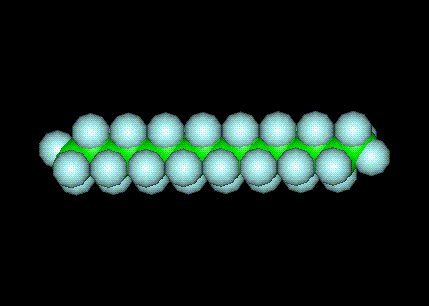Teflon Molecule

For 3-D Structure of Telfon Molecule using Jmol
Teflon is the brand name of a compound discovered by Roy J. Plunkett (1910-1994) of DuPont in 1938 and introduced as a commercial product in 1946. Teflon is polytetrafluoroethene (PTFE).Teflon is also used as the trade name for a polymer with similar properties, perfluoroalkoxy polymer resin (PFA).
:Teflon is the plastic with the lowest coefficient of friction. It is also used as a non-stick coating for pans and other cookware. Teflon is very unreactive, and so is often used in containers and pipework for reactive chemicals. Its melting point is 327 °C.
Teflon is sometimes said to be a spin-off from the US space program with more down-to-earth applications, but actually its first significant use was in the Manhattan Project, as a material to contain highly-reactive uranium hexafluoride. It was first sold commercially in 1946.
Teflon has been supplemented with another DuPont product, Silverstone, a three-coat fluoropolymer system that produces a more durable finish than Teflon. Silverstone was released in 1976. In the US, gun control advocates have campaigned against Teflon-coated armor-piercing "cop-killer" bullets. Actually, many types of bullets are coated with Teflon—to reduce friction and abrasion as the bullet passes through the gun. Teflon has been implicated in cancer, though DuPont denies any association.
History
PTFE was accidentally invented by Roy Plunkett of Kinetic Chemicals in New Jersey in 1938. While Plunkett was attempting to make a new CFC refrigerant, the tetrafluoroethylene gas in its pressure bottle stopped flowing before the bottle's weight had dropped to the point signaling "empty." Since Plunkett was measuring the amount of gas used by weighing the bottle, he became curious as to the source of the weight, and finally resorted to sawing the bottle apart. Inside, he found it coated with a waxy white material which was oddly slippery. Analysis of the material showed that it was polymerized perfluoroethylene, with the iron from the inside of the container having acted as a catalyst at high pressure. Kinetic Chemicals patented the new fluorinated plastic (analogous to known polyethylene) in 1941 and registered the Teflon trademark in 1945.
An early advanced use was in the Manhattan Project as a material to coat valves and seals in the pipes holding highly reactive uranium hexafluoride at the vast K-25 uranium enrichment plant at Oak Ridge, Tennessee.[5] DuPont, which founded Kinetic Chemicals in partnership with General Motors, was producing over two million pounds (900 tons) of Teflon per year in Parkersburg, West Virginia, by 1948.[6] In 1954, French engineer Marc Grégoire created the first pan coated with Teflon non-stick resin under the brand name of Tefal after his wife urged him to try the material he had been using on fishing tackle on her cooking pans. In the United States, Kansas City, Missouri resident Marion A. Trozzolo, who had been using the substance on scientific utensils, marketed the first US-made Teflon coated frying pan, "The Happy Pan," in 1961.
Properties
PTFE is a thermoplastic polymer, which is a white solid at room temperature, with a density of about 2.2 g/cm3. According to DuPont, its melting point is 327 °C (621 °F), but its mechanical properties degrade above 260 °C (500 °F). PTFE gains its properties from the aggregate effect of carbon-fluorine bonds, as do all fluorocarbons.
The coefficient of friction of plastics is usually measured against polished steel.[10] PTFE's coefficient of friction is 0.05 to 0.10,[9] which is the third-lowest of any known solid material (BAM being the first, with a coefficient of friction of 0.02; diamond-like carbon being second-lowest at 0.05). PTFE's resistance to van der Waals forces means that it is the only known surface to which a gecko cannot stick.
PTFE has excellent dielectric properties. This is especially true at high radio frequencies, making it suitable for use as an insulator in cables and connector assemblies and as a material for printed circuit boards used at microwave frequencies. Combined with its high melting temperature, this makes it the material of choice as a high-performance substitute for the weaker and lower melting point polyethylene that is commonly used in low-cost applications.
Because of its chemical inertness, PTFE cannot be cross-linked like an elastomer. Therefore, it has no "memory" and is subject to creep. This is advantageous when used as a seal, because the material creeps a small amount to conform to the mating surface. However, to keep the seal from creeping too much, fillers are used, which can also improve wear resistance and reduce friction. Sometimes, metal springs apply continuous force to PTFE seals to give good contact, while permitting a beneficially low percentage of creep.